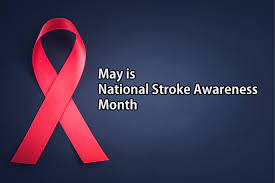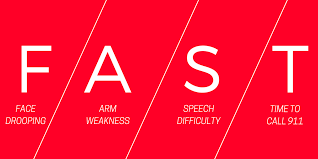Understanding Stroke and Minimizing Risks
October 26, 2022
May is National Stroke Awareness month. According to Medicare.gov, stroke is the 5th leading cause of death in the United States and a major contributor to disability afterwards. Those 65 and over are at greatest risk; however, stroke can occur at a younger age. Fortunately, through advancements in treatment, overall survival has improved as well as health outcomes. More good news is that up to 80% of strokes may be prevented by maintaining a healthy lifestyle to minimize the risks.
Under normal circumstance, our brain cells receive a continuous supply of blood which carries oxygen and other nutrients to sustain them. Stroke or cerebral vascular accident (CVA) occurs when this blood supply is disrupted leading to death of the affected brain cells. Most strokes occur when a blood clot stops the flow of blood within a brain artery. This may happen when plaque containing cholesterol has opened within the artery or when a blood clot or other mass travels from another part of the body to the brain and results in blockage. A stroke also occurs when a weakened blood vessel ruptures in the brain causing bleeding and compression of the surrounding tissue.
It’s critical to obtain fast treatment if there are warning signs of a stroke. The American Stroke Association recommends remembering to quickly identify some common, sudden symptoms of stroke and act immediately.
- Face Drooping (Check if smile is uneven)
- Arm/Leg Weakness (Is one arm immobile or falling lower if asked to raise both?)
- Speech Slurred (Is it difficult to understand simple statements?)
Time to Call 911
Symptoms of stroke can vary based on the area of brain affected and the body’s processes controlled by that region. Other common signs of a stroke include sudden confusion or difficulty comprehending others, vision loss in one or both eyes, loss of balance or dizziness, and severe headache with unknown cause. Calling 911 immediately for emergent treatment may help to minimize the risk of death and debilitating outcomes. A neurological evaluation and testing, such as, a Brain CT Scan or MRI, are normally done to diagnose a stroke. Under certain conditions, a drug may be administered to dissolve the clots and restore blood flow if administered soon after symptom onset. Depending on the prognosis, the physician may order comprehensive rehabilitation for those who suffered significant impairments from a stroke. The goal is to help the patient regain optimal mobility and independence.
Below are a number of known stroke risk factors:
- Ages 65 and over
- Family history of stroke especially if event was prior to age 65
- Female gender notably with advanced age, pregnancy and certain related conditions, history of smoking with contraceptive medication use, and receipt of hormonal therapy after menopause
- African-American and Hispanic races
In addition, a person who has had a previous heart attack, stroke or Transient Ischemic Attack (TIA) is at a much greater risk for a stroke. The same type of plaque-filled blockages that cause a heart attack are responsible for most strokes. TIAs are caused by similar but smaller blockages in the brain that are temporary or passing. Although TIA symptoms may be stroke-like, they are typically mild and without long-term effects. Nevertheless, it’s still critical to contact 911 for emergent care if symptoms develop.

There are other considerable stroke risks that may be minimized by altering lifestyle choices. These risks include atherosclerosis, high blood pressure, atrial fibrillation, diabetes, COVID-19 infection, smoking, obesity, high cholesterol diet, alcohol and drug abuse, and inadequate sleep and sleep apnea. It’s also essential to receive a yearly physical examination from your physician to help identify any potential conditions and plan treatment accordingly. In addition, if your age is 65 and over, it’s important to schedule your Annual Medicare Wellness Visit with your physician. Medicare provides this benefit at no cost because it leads to early detection and treatment of chronic diseases including those that may lead to a stroke. This visit consists of certain checks and screenings, and an in-depth review of your family history to identify possible health risks. Medicare also offers other preventive services to promote well-being, such as, nutritional and obesity behavioral therapies, counseling for smoking cessation and alcohol misuse, and cardiovascular and diabetes disease screenings including testing and education. More information about the Annual Medicare Wellness Visit and other preventive services may be found at https://www.medicareinteractive.org/get-answers/medicare-covered-services/preventive-services/annual-wellness-visit
Please note due to the rapidly evolving nature of related treatment and studies, the facts and recommendations within this article may have changed since publication.




